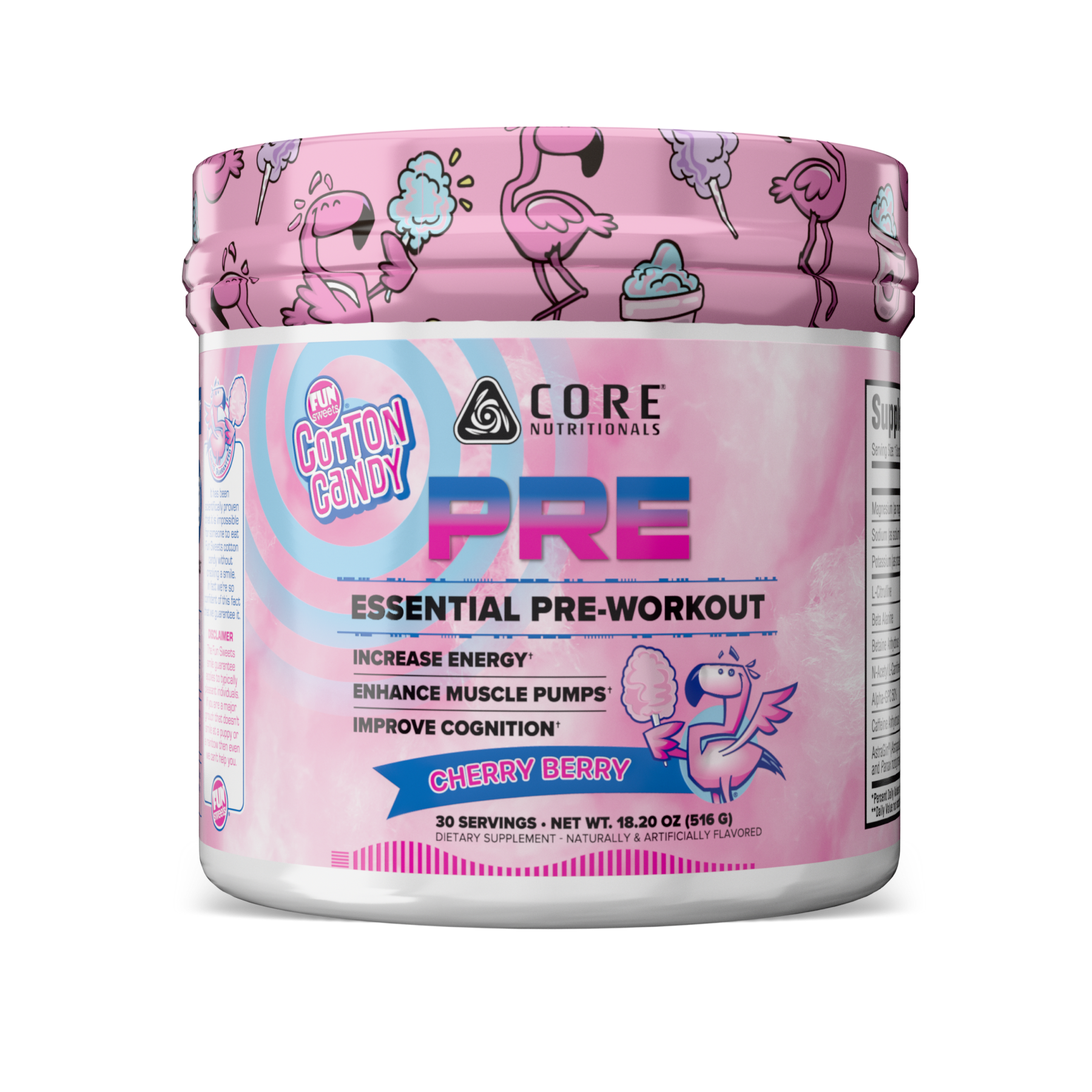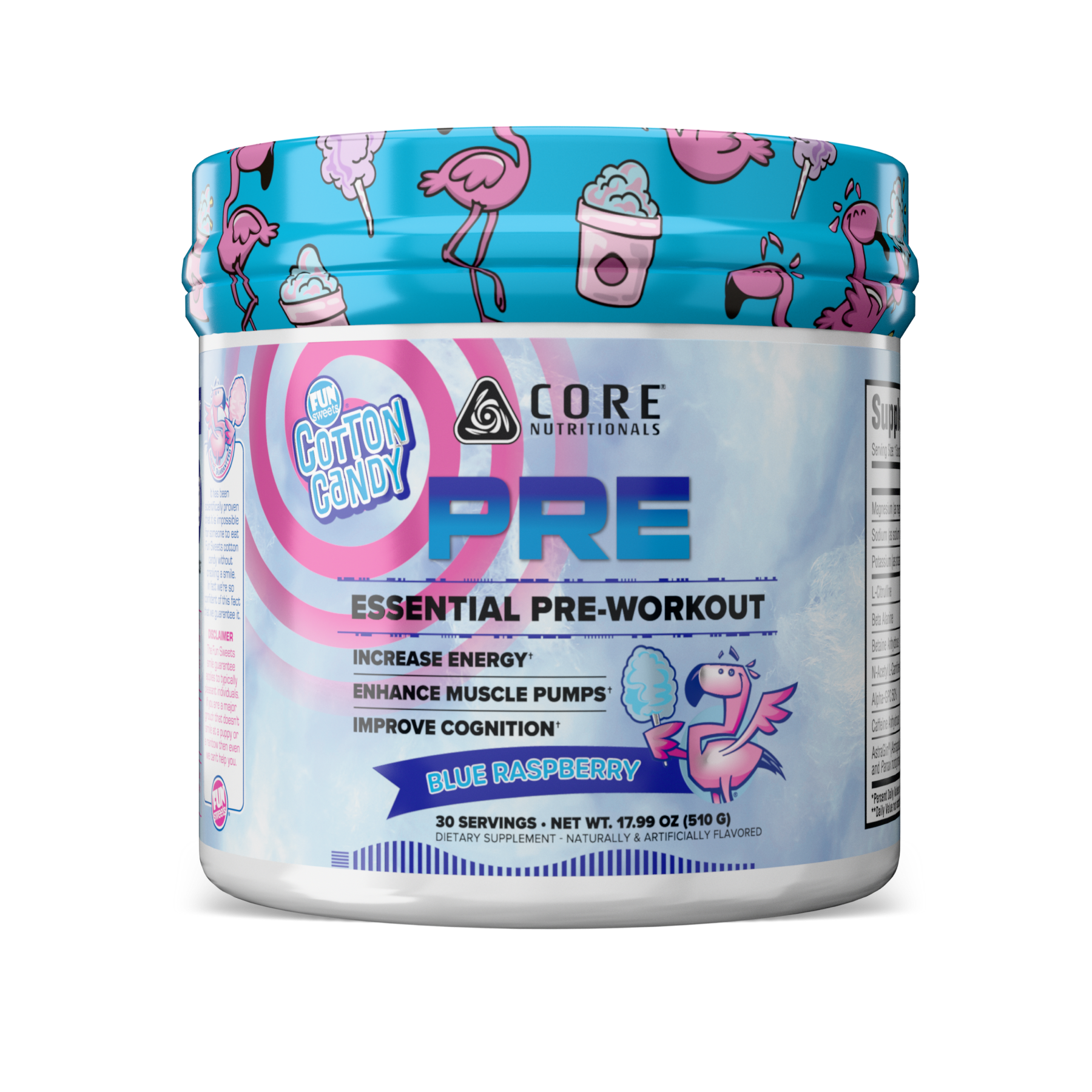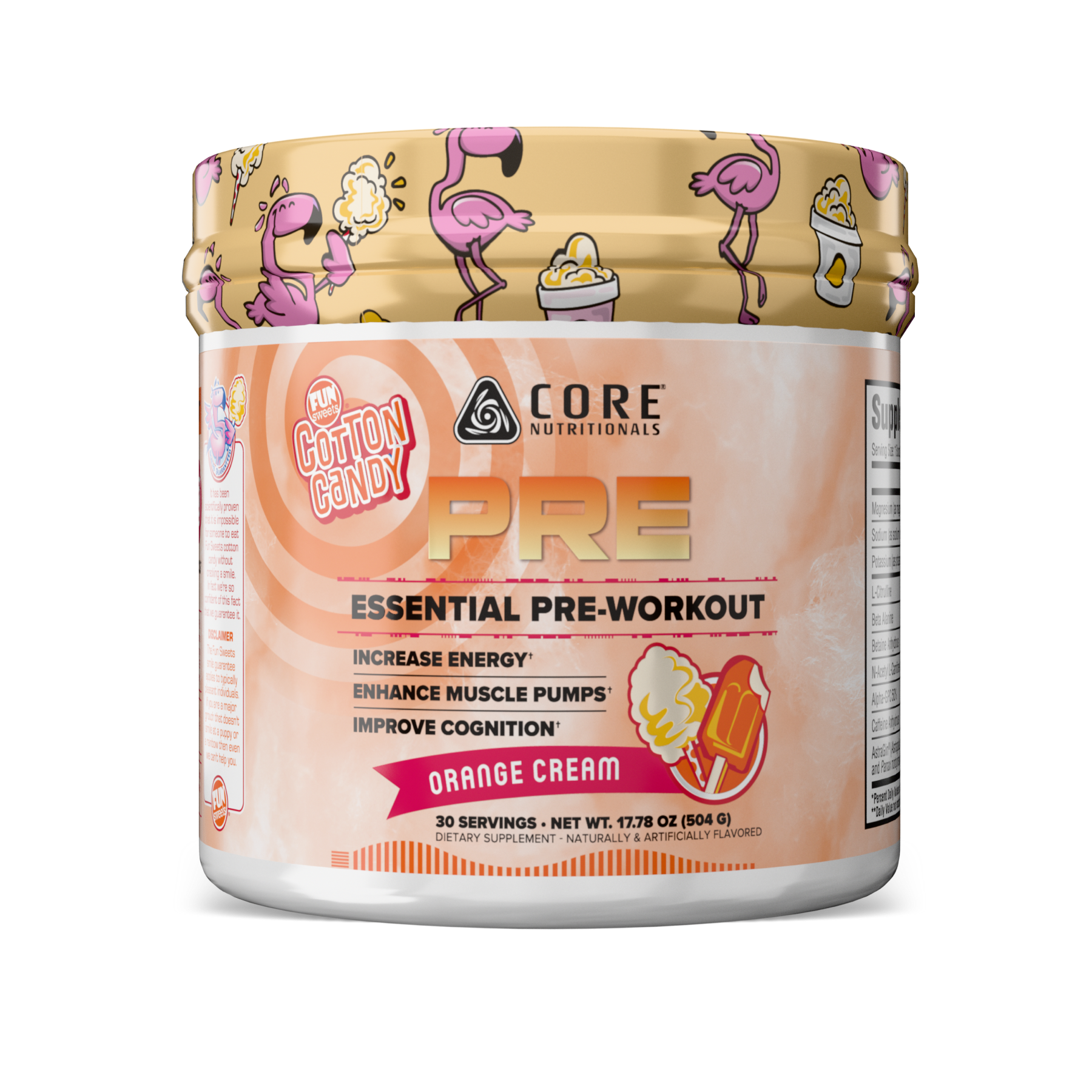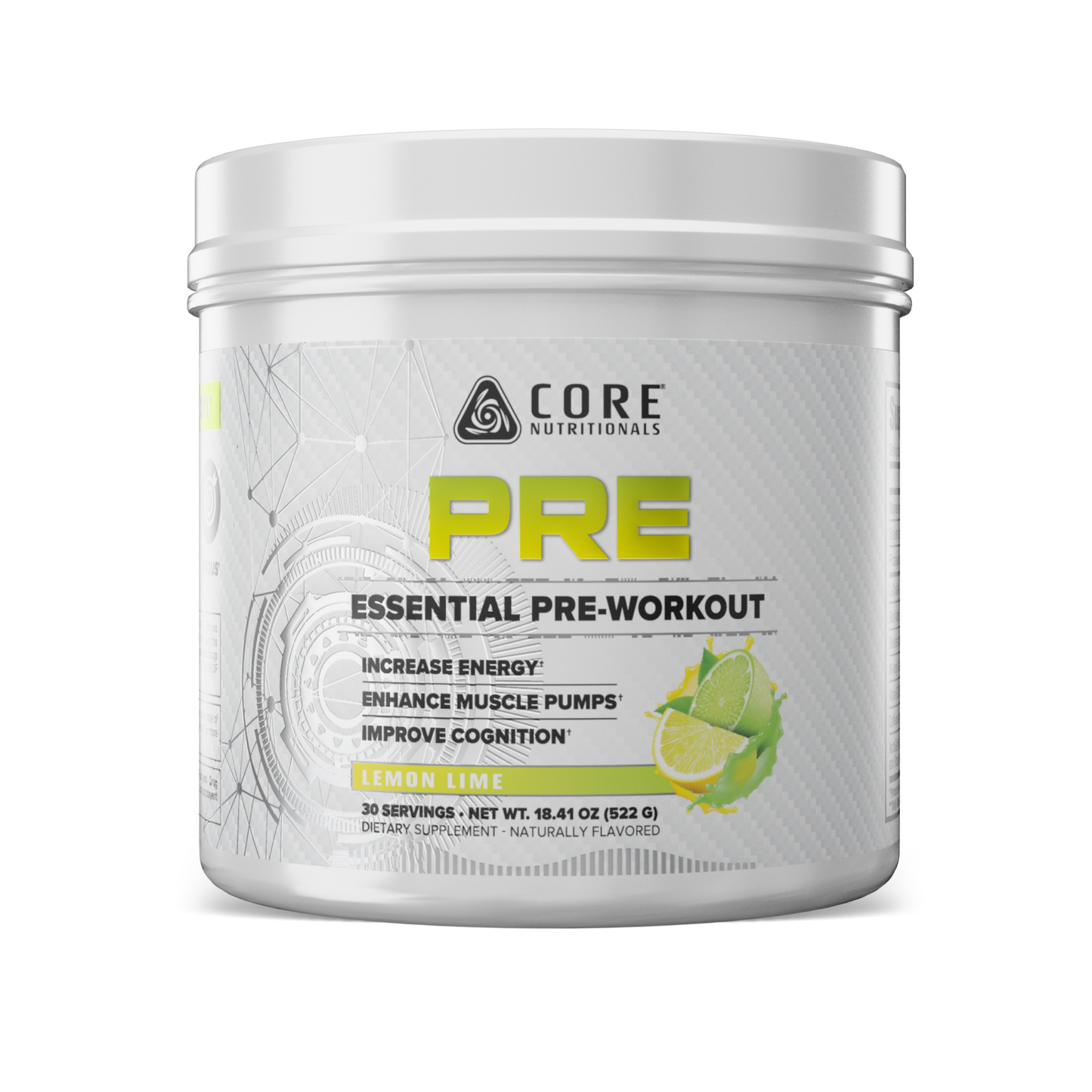
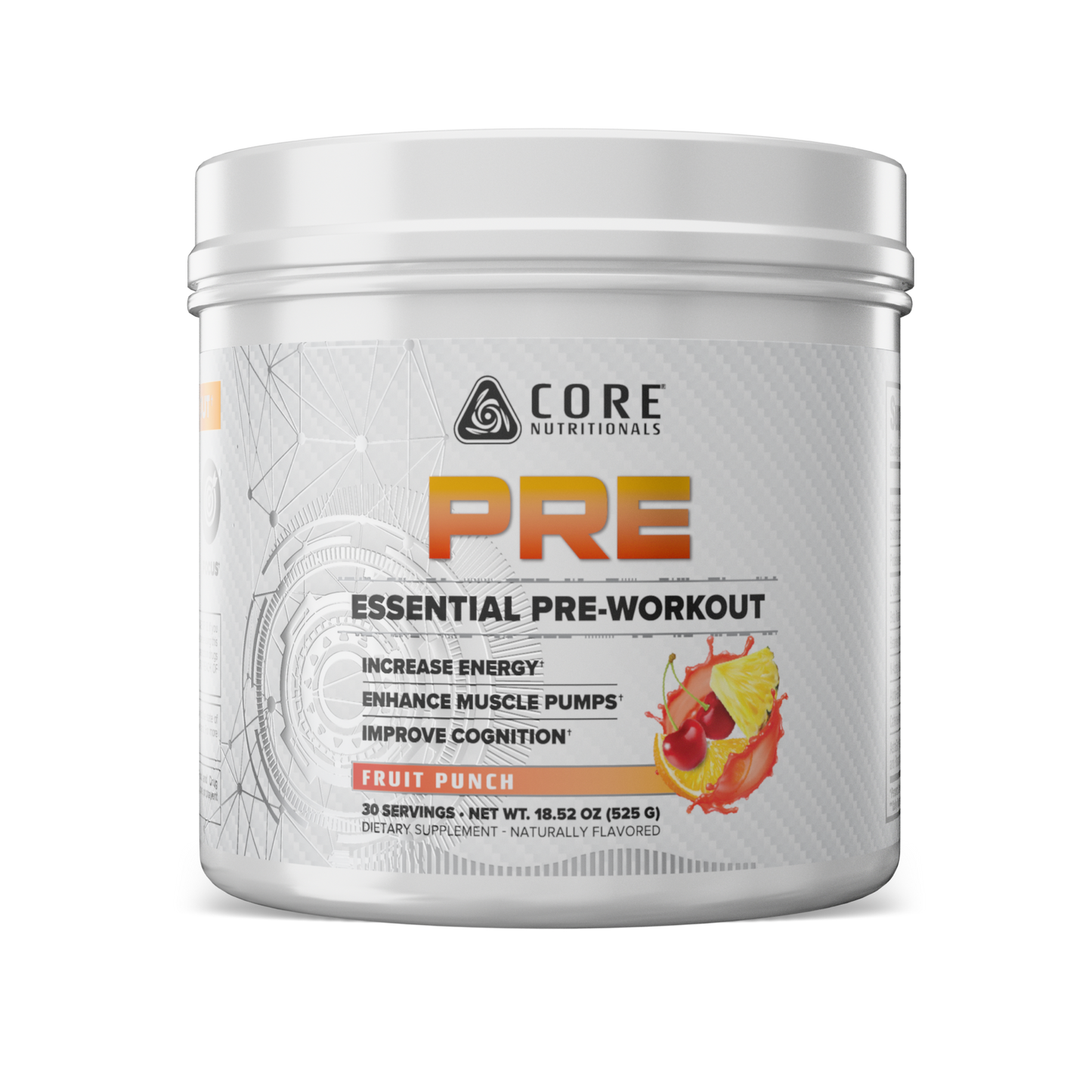
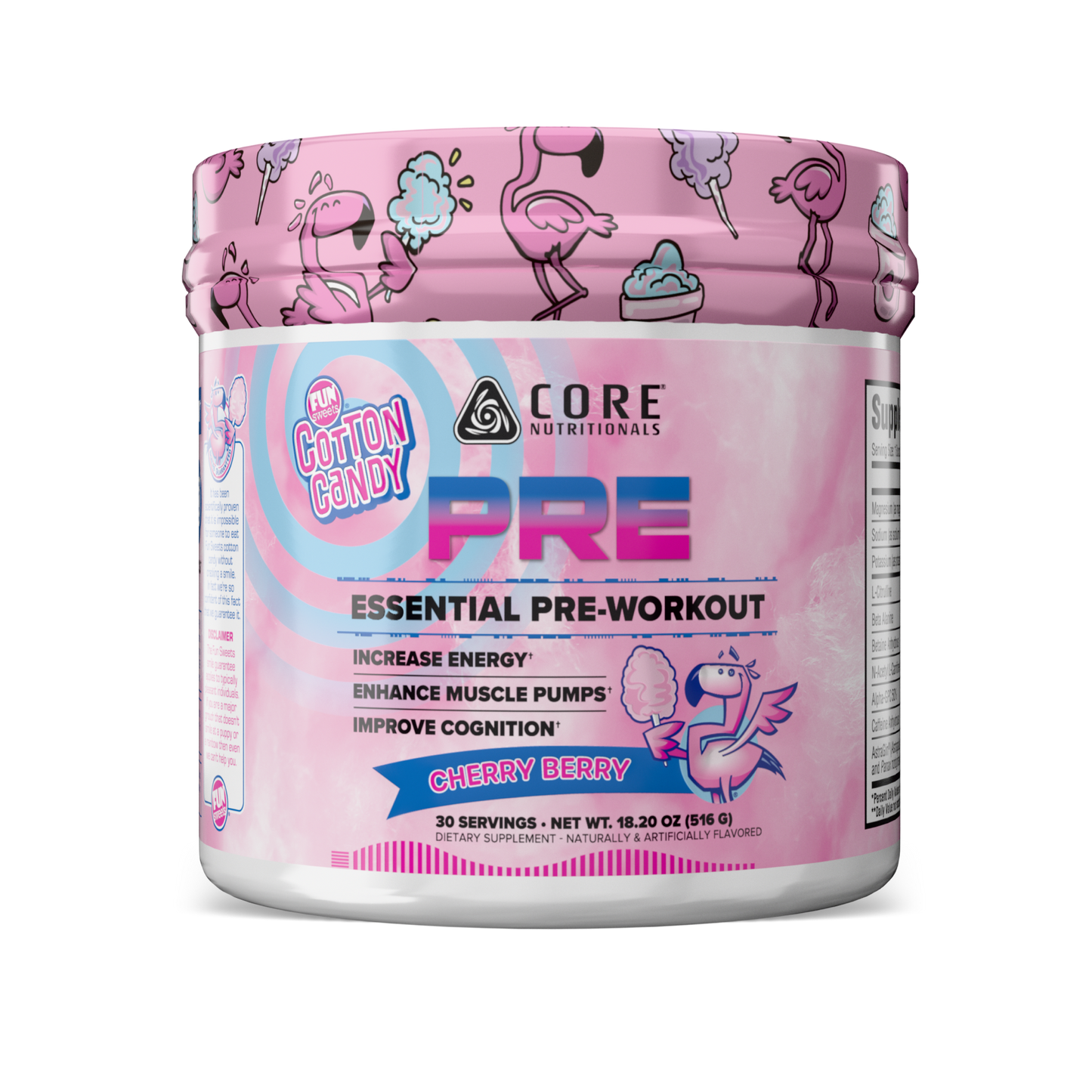
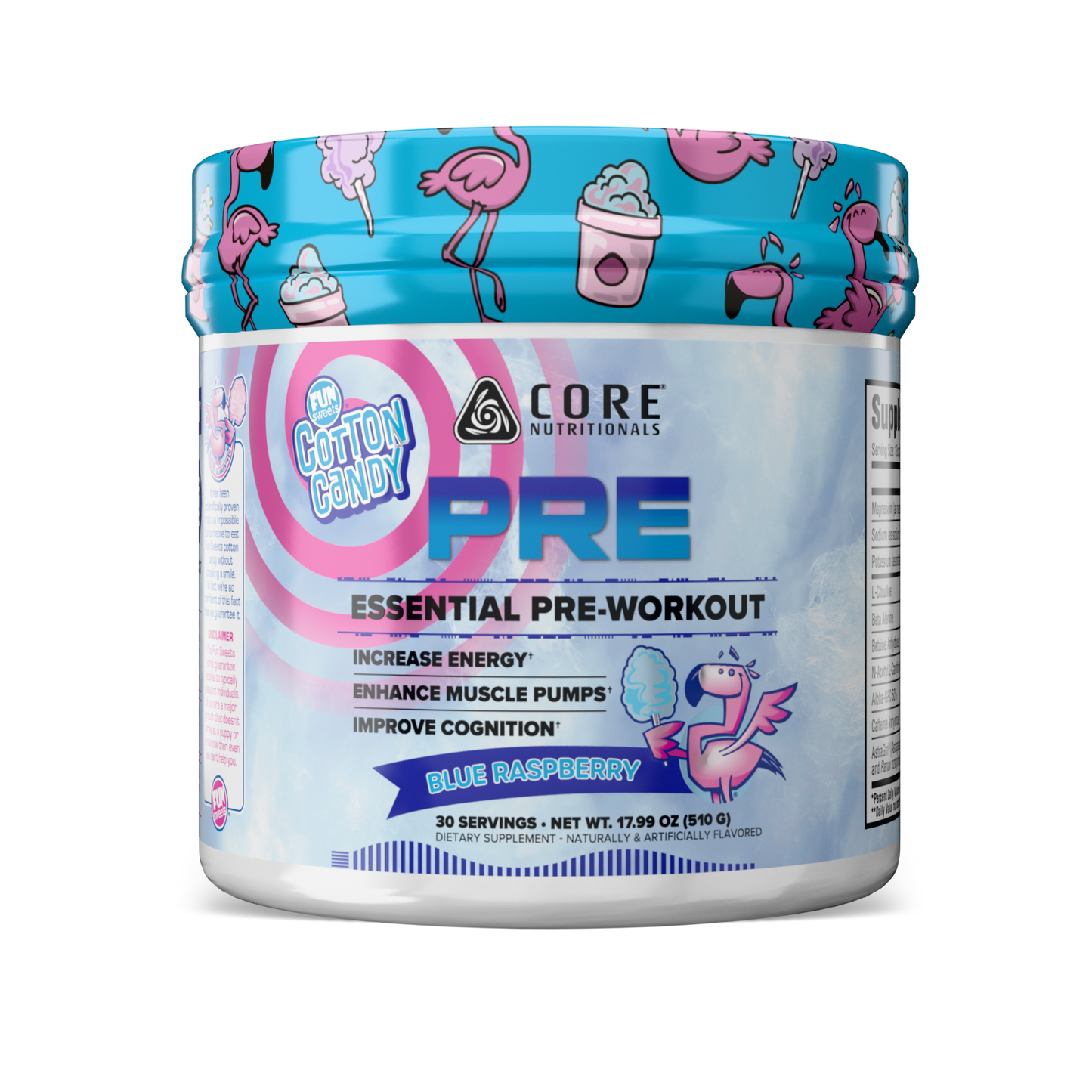
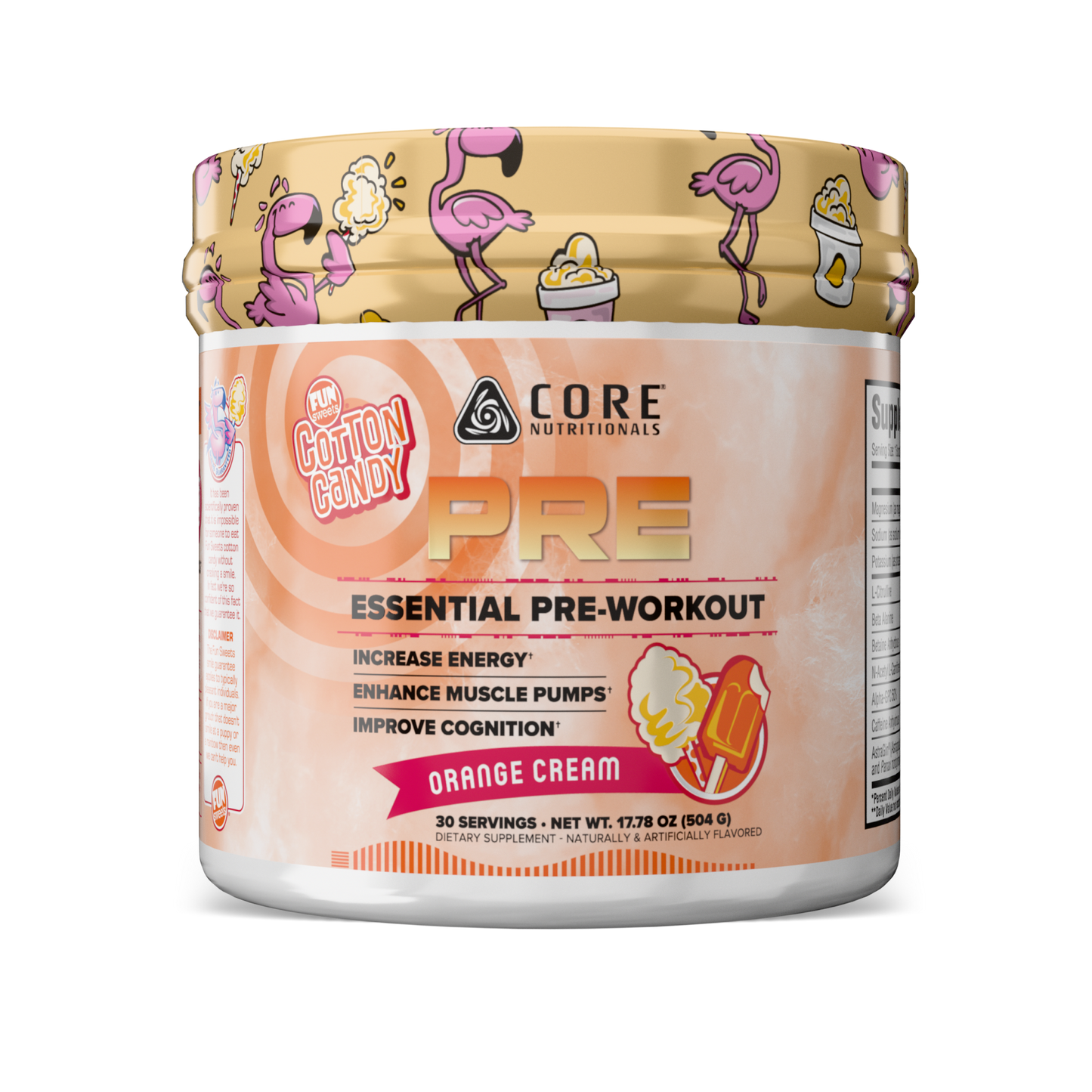
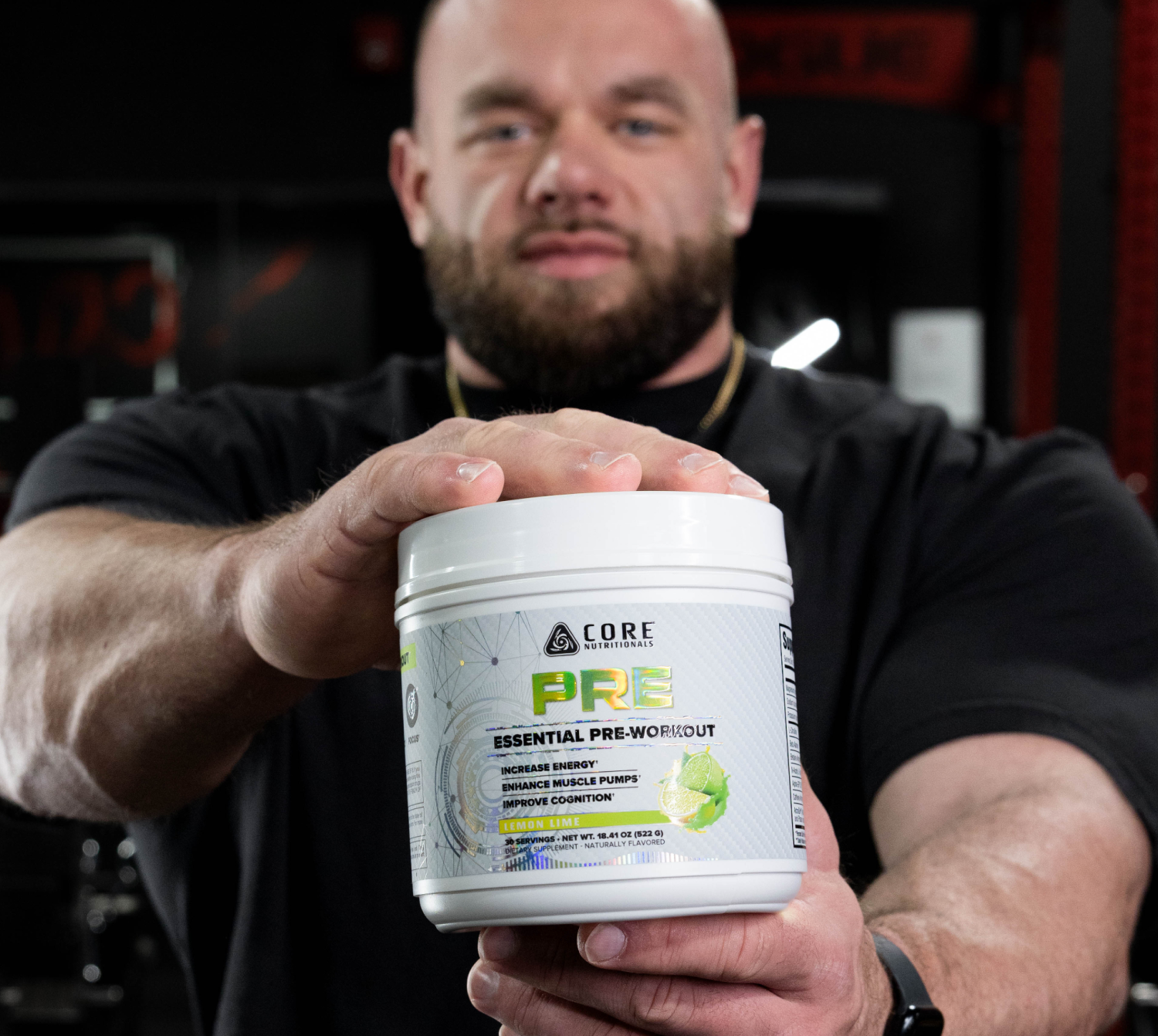
ESSENTIAL PRE-WORKOUT
-
Magnesium (as magnesium citrate), Sodium (as sodium citrate), Potassium (as potassium citrate)
Magnesium, sodium, and potassium are key electrolytes that play a crucial role in performance, endurance, and recovery. These minerals regulate muscle contractions, nerve function, hydration, and energy production, making them indispensable for athletes and active individuals of any age. A deficiency in any of these electrolytes can lead to fatigue, muscle cramps, and decreased exercise performance. Proper supplementation and replenishment of lost electrolytes can ensure optimal function, allowing the body to perform at its best.
Magnesium, a key player in over 300 enzymatic reactions in the body, including those responsible for energy production and muscle function, supports ATP synthesis, ATP is the body's primary energy source, which helps to fuel muscles during intense and rigorous activity. Magnesium also plays a vital role in neuromuscular transmission and relaxation, helping to reduce muscle cramps and spasms that can hinder performance. Additionally, it can help regulate calcium levels, preventing excessive muscle contractions and promoting smoother movement patterns.
Sodium is crucial mineral for fluid balance, hydration, and maintaining blood volume during exercise. It can help retain water within the muscle, ensuring that muscles remain hydrated and capable of sustained contractions during physical activity. Sodium also plays a key role in nerve signaling, allowing efficient communication between the brain and muscles. Without adequate sodium, athletes are more prone to dehydration, dizziness, and muscle fatigue, especially during prolonged or high-intensity workouts where sweat losses are significant.
Potassium works in conjunction with sodium to maintain proper muscle contractions and nerve function. It can help prevent cramps and muscle weakness while also supporting cardiovascular health by regulating heartbeat and blood pressure. Potassium can also aid glycogen storage, ensuring that muscles have a readily available energy source during exercise. A proper balance of potassium and sodium also can prevent excessive water loss, optimizing hydration and endurance.
Together, magnesium, sodium, and potassium form the foundation of optimal performance by enhancing muscle function, preventing fatigue, and supporting hydration. Ensuring adequate intake of these electrolytes through diet or supplementation can lead to improved endurance, reduced recovery time, and better overall athletic performance.
L-Citrulline
Citrulline is a non-essential, non-protein amino acid that forms during the urea cycle and forms ornithine when combined with carbon dioxide. Citrulline is also a critical source of endogenous (natural) arginine, as it is rapidly and efficiently converted to arginine in the vascular endothelium and other tissues.
Citrulline’s benefits have been shown to be greater than its parent compound. While arginine undergoes direct hepatic (liver) metabolism through the enzyme arginase, citrulline bypasses hepatic metabolism entirely and it is delivered straight to the bloodstream. The result is that gut absorption and plasma (blood) bioavailability studies comparing citrulline and arginine have shown two things. First, that citrulline is less readily destroyed and has greater absorption than arginine. Second, that citrulline supplementation increases arginine levels more effectively than arginine supplementation itself.
This translates to promising results. For example, animal studies show a significant increase in anaerobic performance at a 250mg/kg/day serving of citrulline, while studies in humans implicate citrulline in both aerobic and anaerobic performance increases. As a critical part of the urea cycle, citrulline’s performance benefits are thought to be a result of its role in ammonia clearance.
Citrulline is implicated in reducing the oxygen cost of muscle processes, along with increasing the rate of post-exercise ATP and phosphocreatine replenishment. As ATP and phosphocreatine are the body’s ‘exercise fuel,’ this may result in citrulline delaying time to exhaustion in aerobic and anaerobic exercise.
Beta Alanine
Carnosine is a bit of an odd duck: we know that it is crucial for muscle function, and that dietary sources of carnosine are essential, but we don’t know precisely how it works. Moreover, for decades, we had no idea how to increase intramuscular concentrations, as exogenous carnosine sources degraded in the body so fast as to be effectively useless.
Enter beta-alanine. Simply a different iteration of one of the amino acids that comprises carnosine itself (alanine), beta-alanine has proven to be the most effective means of significantly increasing intramuscular concentrations of carnosine – and therefore of promoting all of carnosine’s various beneficial effects on muscle performance. If that weren’t enough, beta-alanine has also demonstrated beneficial physiological effects independent of its parent compound. In order to understand why, though, we need to first understand some of the basics behind carnosine itself.
Carnosine, a cytoplasmic dipeptide synthesized from the precursors L-histidine and l-alanine, is present in high concentrations in skeletal muscle and plays a pivotal role as a, “chemical buffer” in myocytes (muscle cells). It has long been known that carnosine concentrations are highest in glycolytic, rather than oxidative muscle fibers (roughly speaking, explosive vs., endurance muscle fibers, respectively), and thus long hypothesized that this amino acid is required for sustained performance during supramaximal exercise. Recent research demonstrates that carnosine exerts its physiological effects in long hypoxic (low oxygen) drives by functioning as a high-capacity pH buffer in skeletal muscle, preventing the pH ratio of plasma from dropping too low – and therefore preventing crucial pH-dependent processes such as protein synthesis from being inhibited by acidosis.
Despite its critical role in skeletal muscle anaerobic performance, intramyocellular synthesis of carnosine is rate-limited by the availability of l-alanine. Unfortunately, most literature demonstrates that attempting to increase intramuscular levels of carnosine via either direct carnosine or alanine supplementation is largely ineffective due to carnosine/alanine pharmacokinetics. Enter beta-alanine. Research with beta-alanine demonstrates consistent and dose-dependent increases to intramuscular carnosine concentrations with beta-alanine supplementation, with certain studies showing an increase of 40-60% with chronic administration. These same literatures reveal a synergistic effect of exercise on beta-alanine supplementation, whereby the muscle adaptive changes associated with resistance training promote further intramuscular carnosine production in response to beta-alanine supplementation.
In simpler language, this essentially means that beta-alanine is a dietary supplement that promotes its own effects in combination with exercise. As you exercise, you simultaneously intensify beta-alanine’s physiological actions – both directly, as well as in the production of intramuscular carnosine. Once ingested, beta-alanine’s exercise-specific beneficial activity is well-established. Elevation of intramuscular carnosine content via beta-alanine supplementation has been shown to improve performance in the following ways.
- Both acute and chronic increases in total work capacity, measured by total volume during exercise sessions.
- Highly significant increases to TTE (total time to exhaustion), one of the most accurate and comprehensive measures of endurance. In various trials, beta-alanine supplementation has been shown to increase TTE by upwards of 20%.
Increases to total muscle power output in both acute and chronic trials, suggesting that beta-alanine’s most significant benefit is to those engaging in power-dependent resistance training.
In total, a significant body of research exists to suggest that beta-alanine may significantly increase muscle power output, strength, training volume and output, overall performance in hypoxic (oxygen-deprived) conditions and peak VO2 max (oxygen holding capacity).
These myriad benefits make beta-alanine both one of the most-studied, and most well-rounded dietary supplements. Beta-alanine not only has direct, actionable physiological effects, but also promotes critical muscle physiologic adaptations that promote its own effects.
Betaine Anhydrous
Betaine (trimethyl glycine) is found naturally in most living organisms. It is well known to protect non-mammalian animal life in conditions of osmotic stress (a rapid change in the amount of solute surrounding a cell), in addition to functioning as an osmolyte in mammalian (including human) tissues. Betaine is formed in cells as an oxidation product of choline and can be obtained in the diet from foods such as spinach and beets.
Though data on betaine is limited, and recent, the available literature suggests that this compound may have effects in a few areas. Studies on betaine using servings as little as 1.25g/day and up to 5g/day for up to 14 days have shown promising results. In one study, a 2.5g/day serving was found to enhance endurance and total repetition volume for the squat, bench press, and jump squat in in healthy-exercised trained adults. A similar study using the same serving found that betaine use increased peak power and maximum peak power, along with force and the maintenance of both force and power in healthy, exercise-trained subjects.
Perhaps more interesting, however, is a study which examined betaine’s effect on the endocrine system. This study revealed that betaine may exert an effect on several endocrine processes given the proper conditions, causing the authors to hypothesize that long(er) term betaine supplementation may increase the hypertrophic response to resistance training.
N-Acetyl L-Carnitine Hydrochloride
L-carnitine is a derivative of the amino acid lysine and, as certain conditions outpace the body’s ability to produce it, l-carnitine is considered a conditionally essential amino acid. While endogenous biosynthesis of l-carnitine from the amino acids lysine and methionine is sufficient for essential processes – along with dietary sources of carnitine from protein-rich red meat, for example – dietary supplementation of carnitine may pose benefits in certain physiological conditions.
Unfortunately, due to excess metabolism of l-carnitine by microorganisms in the small intestine, exogenous supplementation with oral l-carnitine has proved ineffective. ALCAR, an acetylated version of l-carnitine, has considerably higher oral bioavailability, due likely to only partial hydrolytic metabolism. Once in the bloodstream, ALCAR plays a fundamental role in the production of energy, acting as the catalyst for the beta-oxidation of long chain fatty acids by the mitochondria; regulating the CoA to Acyl-CoA ratio (necessary to produce ATP); and the metabolism of carbohydrates. ALCAR also is an excitatory agent for neurons, increases neuronal transmission, and increases the production of neurotransmitters and neurohormones such as dopamine and serotonin.
Alpha GPC 50%
Of the known choline pro-drugs or precursors, Alpha GPC appears to have exert the greatest influence on circulating choline levels. Choline is an essential nutrient involved in numerous metabolic pathways, including DNA regulation and repair, protein function, and metabolism. Perhaps most importantly, the critical neurotransmitter acetylcholine is produced directly from free choline via cholinergic neurons. Acetylcholine is then responsible for several functions itself, most crucially as the compound which induces muscular contraction, and as the neuromodulator partially responsible for modulating risk/reward, arousal, and enhancing memory.
Choline’s essential role as a substrate for acetylcholine, and therefore brain development, is well documented in animal models. These studies demonstrate that levels of free maternal choline have a direct and fundamental impact on prenatal brain development, with the enhancements or deficits lasting into adulthood. Choline’s enhancing effect is particularly prominent in the hippocampus. In humans, the hippocampus is primarily involved in the consolidation of memory (taking short, episodic memory and translating it into long-term memory) and the learning of new information. Acetylcholine is a critical component in these processes, as mentioned above, and choline may therefore play a potential role in these processes as well by providing the substrate for acetylcholine synthesis.
Whether through these, or other independent mechanisms, a recent trial using Alpha GPC demonstrated a statistically significant increase to power output. In a placebo-controlled, double-blind, randomized trial, 14 healthy volunteers, split into an Alpha GPC or placebo group, were tested on various exercises. In comparison to the placebo group, the Alpha GPC group experienced a 14% increase to bench press. The researchers hypothesize that the peak power increase was the result of a substantial acute increase to growth hormone, one of the observed effects of Alpha GPC supplementation.
Caffeine Anhydrous
Caffeine is one of the most widely consumed, and perhaps one of the most reviewed, psychoactive compounds. Its physiological effects in a range of areas have been well-documented, including exercise performance, information processing, alertness and mood enhancement, attention, and awareness, along with its anti-lipogenic and lipolytic abilities.
Most importantly to Core PRE, caffeine has been shown to have significant effects on exercise performance, even with ingestion in servings as small 3 to 9mg/kg/bw/day (the equivalent of 2 cups of standard coffee, for a 170lb male). In endurance training, possible explanations for caffeine’s performance-enhancing effects lie in its metabolic effects on both lean and fat tissue. It is suggested that caffeine’s potent lipolytic (the breakdown of fat tissue into fatty acids) and oxidative (the actual ‘burning’ of fat) action allow the body to utilize these sources during prolonged submaximal exercise. Consequently, muscle glycogen is spared and available for use later in the training session. Practically speaking, this means caffeine is forcing your body to preferentially use fat tissue as a fuel source, while sparing the glycogen which gives you the full-bodied look!
In short-term exercise, caffeine’s demonstrated role in the inhibition of cyclic AMP- phosphodiesterase’s (PDE), adenosine receptor antagonism, and adrenoreceptor agonism come into play. These three pathways collectively stimulate lipolytic activity, boost fat metabolism, increase metabolic rate and energy expenditure, and regulate the body’s thermogenic activity. The practical results of activating these pathways are increases to the contractile force of both cardiac and skeletal muscle (harder flexion), an increase in energy expenditure (freeing up more caloric energy to be used in contraction), dilation of vasculature (better blood flow), and improvements to both nitrogen retention and skeletal muscle protein synthesis (key components to muscle building).
In Core PRE, we have included a per-serving amount of caffeine that is neither excessive, nor arbitrary, but that instead reflects the servings used in clinical research.
AstraGin® (Astragalus membranaceus and Panax notoginseng Root Extracts)
AstraGin® is a trademarked combination of Astragalus membranaceous and Panax notoginseng that has been widely used in the supplement manufacturing industry largely for due to its clinically studied benefits for improving absorption of nutrients, peptides, and amino acids. Some statistics include increased absorption of creatine, leucine, citrulline, and other peptides by up to 67%, increased curcumin absorption by 92%, increases polyunsaturated fatty acids (from flax and fish oil) by 58% and 100% respectively, as well as can increase ATP production in the liver by 18%. AstraGin® has been shown capable of increasing muscle protein synthesis and increased mTOR through enhanced leucine absorption, which has an influence on improved glucose metabolism and mitochondrial functions. In addition to this benefit, AstraGin’s® ability to enhance polyunsaturated fatty acid absorption while also inhibiting saturated fatty acid absorption, thus reducing the risk of impaired glucose metabolism and mitochondrial function, can enhance ATP synthesis through mitochondrial respiration, and increase oxidative phosphorylation.
It has been further studied how Astragalus and Panax notoginseng specifically can protect mitochondria and enhance their function towards anti-aging. The proposed mechanism leads to Astragalus acting as a free radical scavenger, which can inhibit mitochondrial permeability transition and increase the activity of antioxidants against the peroxidation of membrane lipids. Panax notoginseng also works in a similar fashion through decreased free radical production. This lipid peroxidation has been shown to be a major cause of decreases in mitochondrial function. In addition to this, ensuring a highly permeable environment around the mitochondrial membrane is crucial for maintaining mitochondrial functions. This permeability allows for the passage of key electro chemicals to cross the gradient allowing for the process of energy development for the cells.
-





